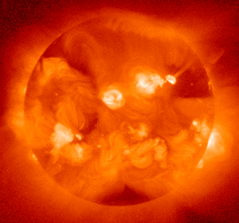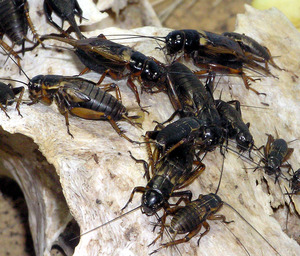The ALMA Telescope, Solar Orbiter, Autistic Mice and Chivalrous Crickets.
Interview with
ALMA opens up to the Universe
Understanding the origins of the Universe is now within our grasp thanks to a new
a new
radio telescope turned on this in Chile.
The Atacama Large Millimetre array, or ALMA, located high up in the Atacama desert of the Chilean Andes, is the largest, most expensive ground-based telescope ever built. With an array of 66 giant antennae, it will enable scientists to probe deep Space using wavelengths of light never observed before, to explore the early universe as ALMA's Antonio Hales explains...
"Between the radio and far infrared frequencies, lies the millimetre and submillimetre range which is where ALMA will operate. It carries information on the cold universe - cold clouds of dust and gas in which galaxies form. So ALMA will provide observations of those very first galaxies, how did they form? How the stars in those galaxies form? And how did those galaxies and those stars evolve in order to form the universe we see today?"
Autistic Mice
Scientists have created
micewith the rodent equivalent of the human condition Autism.
By adding to experimental animals, extra copies of a gene called Ube3a, which has previously been linked to Autism in humans, Harvard Medical School scientist Matt Anderson and his colleagues have been able to produce mice showing similar communication and behavioural problems to those seen in Autistic patients...
"The mice show no social interaction, have reduced speech or communication and they have increased repetitive behaviours. There's really very little used right now to improve communication and social interaction. Most of the therapies are directed towards the associated symptoms like anxiety, sleep disturbances, epilepsy. I think that this tool is going to be a great way to try to find things that will treat those core symptoms."
 Journey to the Sun
Journey to the Sun
The European space agency has this week agreed to lead the biggest project yet to study the behaviour of our Sun.
The 7 year
Solar Orbiter mission, due to launch in 2017, will involve the construction of a shielded probe that will orbit at 42 million kilometres from the Sun, a distance closer than any spacecraft to date and nearer even than the orbit of Mercury. Exposed to temperatures of up to 5000 degrees Celsius, the probe will provide unprecedented insight into the workings of our nearest star and how it affects the Earth. Fabio Favata from the European Space Agency...
"By doing this, we'll observe the origin or phenomena such as the coronal mass ejections or even the simple solar wind, especially more and more in an era in which we're relying more and more on high technological equipment. We're relying on satellite communication and satellite navigation and so forth. So in addition to probing some very elemental scientific questions, it will also help us to understand the influence of those mechanisms on Earth and therefore, cater for them, prevent damage and so forth."
Virtual Monkey Movements
Monkeys have been trained to
control a virtual arm on a computer using activity recorded from their brains.
The device created by Duke University's Miguel Nicolelis allowed the monkeys to move and feel objects in a virtual world controlled purely by their thoughts. Electrical signals were also sent back to their brains to distinguish the textures of the objects they were touching. The team hope to develop the technology to help paralysed patients...
"Basically, what we have done is to create the first brain-machine-brain interface that allows both electrical signals from the brain to control the movements of artificial devices and also to provide tactile feedback from these devices directly to the brain without interference from the body of the subject. This has the aim of creating a new generation of neuroprosthetic devices. A whole body robotic vest and exoskeleton that will be used to restore mobility in severely paralysed patients."
 Chivalrous Crickets
Chivalrous Crickets
And finally, it seems chivalry isn't dead after all. Well in crickets that is.
Studying field crickets in the wild, Rolando Rodrigez-Munoz found that when mated pairs of crickets entered their burrows, males allowed their female partners to seek sanctuary first whilst they waited outside, increasing their own risk of predation and putting their own lives at risk. But as a reward, these males got to mate with the female more frequently, resulting in more offspring inheriting their genes...
"Most people are thinking that this behaviour would be more likely to happen in humans or closely related mammals, but we can see that even small insects can be seen being chivalrous with females. So it's good for both. Males get more offspring and females reduce their risk of being predated."
The findings counter previous theories that males guard in this way to stop other males mating with the females. The males are effectively trading a long life for one with greater reproductive success.









Comments
Add a comment